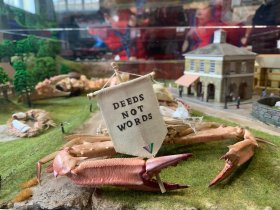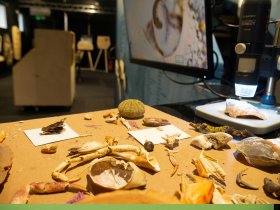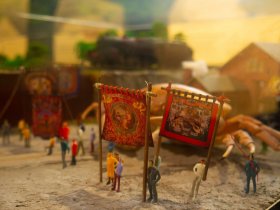Stay in touch with the latest news from AIM and get information on sector grants, jobs and events with our free fortnightly E-News.
Museum Profile – Crab Museum
Crab Museum is an independent free-to-enter science museum based in Margate. It uses crabs as a lens through which to explore the interconnectedness of life on Earth in all its bizarre, vast, and complicated weirdness.
Crab Museum exists as a place for children and adults to come together and explore the sciences in an accessible way. While our focus is on crabs and decapod crustacea more generally, we use these animals to scaffold engagement with other, seemingly disparate disciplines, as we believe in the entanglement of all knowledge – history doesn’t end when you leave the history classroom and enter the English one.
The museum aims to bewilder, bemuse, and inspire a generation of children with our own brand of extreme whimsy that seeks to demonstrate that science is for everyone, and that through knowledge comes hope for the future. The museum regularly receives between 100 – 200 visitors each day and in 2022 we welcomed 22,000 people through our doors.
Crab Museum is entirely independently funded by our gift shop, online shop sales and director personal investment.
The museum’s core staff are the three directors and a small cohort of brilliant volunteers who help run the shop and our digital microscope displays. We opened to the public in late 2021, born from a desire to present science, and crucially the climate crisis, in a way that was neither tokenistic nor apocalyptic. Our founding principle was that you can use anything to talk about anything else, the museum is intended as physical proof of that. We built the museum over Covid, conducting the refit of the building ourselves.
Margate as a town has a wide variety of art galleries and cultural institutions that have directly benefited the town’s regeneration,
however, there has always been a lack of educational destinations for local children or visitors to the town. Two of the three directors are from Margate, the other is from just over the estuary in Canvey Island and the museum attempts to redress the uninspiring science communication we received during our own schooling.
Highlights of the museum include our diorama of Crabton-On-Tyne, a model village scene set during the 1926 general strike. This exhibit demonstrates the flexibility of memory and nationhood, depicting forgotten and remembered histories and how they exist
as reflections of dominant power structures. It is populated by Hornby trains and taxidemied crabs wearing hats.
However, the main highlight of the museum is our digital microscope at the counter ‘The Crustacean Identification and Magnification Station’. This is where museum staff go through various specimens that we’ve collected from the beach and that have been donated by the public. It is in the conversations with visitors that they can further join topics as diverse as anatomy to the reclassification of snow crabs as seabed resources by the Norwegian and Russian governments. We believe museums exist for people’s ideas, not just to be an archive for disassociated, decontextualised objects.
Click here to visit the Crab Museum website>>



